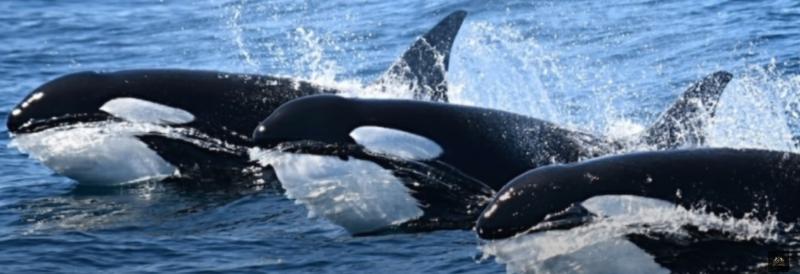 Since 2020, juvenile orcas within pods that feed on migrating tuna traveling through the Strait of Gibraltar and around the Iberian Peninsula, have taken to bumping and ramming the hulls of small yachts and damaging rudders. In the last several years there have been over 100 orca ‘interactions’ where boats have been spun around and repeatedly rammed. Up to 15% of yachts experiencing this behavior have had to be towed to port, usually due to steering gear damage. In two such attacks, damage done by the orcas resulted in the yachts sinking.
Since 2020, juvenile orcas within pods that feed on migrating tuna traveling through the Strait of Gibraltar and around the Iberian Peninsula, have taken to bumping and ramming the hulls of small yachts and damaging rudders. In the last several years there have been over 100 orca ‘interactions’ where boats have been spun around and repeatedly rammed. Up to 15% of yachts experiencing this behavior have had to be towed to port, usually due to steering gear damage. In two such attacks, damage done by the orcas resulted in the yachts sinking.
Why the primarily juvenile orcas have taken to attacking sailboats has mystified scientists. Recently, two theories have been proposed that might explain the behavior.
Pod Fads
Some researchers suggest that the behaviors are simply “fads” that have spread between related pods. LiveScience.com notes that orcas are highly social animals and do sometimes pick up behaviors from one another in a way that strongly resembles human fads.
In 1987, for example, orcas in Puget Sound began wearing dead salmon like hats. According to a 2004 paper in Biological Conservation, one female orca started the trend, and it spread like a viral TikTok challenge through two other pods. After about six weeks, the orcas stopped putting salmon on their heads; a few tried to bring the trend back the next summer, but the fad was done.
Dolphins, which are also social cetaceans like orcas, also have fads. One 2018 study in the journal Biology Letters reported that wild dolphins in southern Australia may have gotten into the cool new trend of “tail walking” thanks to a dolphin that was temporarily housed in a rehabilitation center as a calf.
The dolphin wasn’t trained while being cared for by humans, but had the opportunity to watch captive dolphins tail-walk, a move in which a dolphin raises most of its body out of the water vertically and skims backward using its tail fin. A few years after the dolphin was tagged and released back into the Port River Estuary, dolphins in the area spontaneously started tail-walking. The trend continued for over a decade, peaking around the time the (possibly) trendsetting dolphin died and finally fading out in 2014.
Scientists also speculated that perhaps the orcas are simply fascinated by moving boat parts. Juvenile males are often very curious and playful. Renaud de Stephanis, president and coordinator at CIRCE Conservación Information and Research, a cetacean research group based in Spain, said he believes that the boat attacks are the work of some mischievous adolescents. If that’s the case, the orcas will probably outgrow their bad behavior, not unlike human teens.
“This is a game,” de Stephanis said. “When they … have their own adult life, it will probably stop.”
Black Antifouling Hull Paint
The British Cruising Association, in collaboration with Groupo Trabajo Orca Atlantica (GTOA), has been collecting and analyzing data on the orca attacks and observed an interesting relationship. A high percentage of boats that have been attacked have black antifouling hull paint. A lower percentage of boats with black antifouling paint have had trouble-free voyages.
John Burbeck, who leads the Cruising Association’s orca task force, observes that “If, on trouble-free voyages, you’ve only got 25 percent of boats with black antifouling, why on the attack side, have you got more than 50 percent with black?” The risk appears to double with black antifouling paint.
He repeatedly stresses that black antifoul is a ‘possible’ concern, and until more data is collected, it can only remain that.
Seals and Rubber Kayak Hulls
The suggestion that black hull paint may attract orcas, brought to mind a personal experience from years ago. My wife and I were kayaking with another couple off Isle au Haut, Maine. We were paddling a Klepper folding kayaking with a black neoprene hull. The other couple was paddling a red fiberglass kayak.
We noticed that a group of seals had broken away from a herd playing in rocks off the island and had begun to follow the black-hulled Klepper, while completely ignoring the red kayak. The seals kept getting closer to the black-hulled kayak until they finally lost interest and returned to their herd.
We guessed that the shiny, black, and flexible kayak hull might have looked like a particularly large seal, particularly from underwater, and could have piqued the seals’ curiosity.
While our experience with seals may not be directly analogous to orcas’ behavior with black sailboat hulls, it is conceivable that juvenile orcas are reacting faddishly to dark sailboat hulls as surrogates for whales. Or perhaps not. Whether the aggressive behavior of the Iberian orcas proves to be just a fad remains to be seen.

A very interesting and enjoyable read !